
|
|
85%
Abstract: Thermalfly's I75DUH heatsink is equipped with a 96mm fan that rotates as lackadaisically as 500RPM, yet it can scale up to 2300RPM when the needs demand.
|
Home >
Reviews >
Page: 360° View - Thermalfly I75DUH Heatsink
|
360° View - Thermalfly I75DUH
Heatsink
Information on Frostytech's test
methodology is available here. | |
|
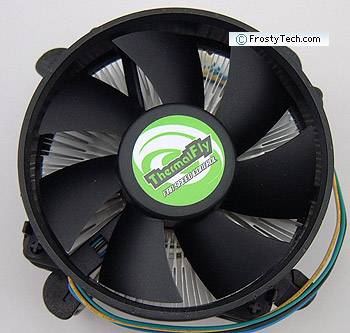 |
The Heatsink Fan:
The Thermalfly I75DUH heatsink is
built with a 95mm diameter fan. The 7-bladed impeller on this Pulse
Width Modulation (PWM) fan spins at speeds of 500-2300RPM when
controlled by the computer's BIOS. Power is supplied by
the 4-pin PWM fan cable which connects to a
standard 3-pin or 4-pin motherboard fan header. The fan defaults
to a speed of 2300RPM when the PWM-signal is absent. There is
an 11mm plenum between the top of the aluminum fins, and the bottom
of the fan impeller to promote even airflow distribution within the airframe.
|
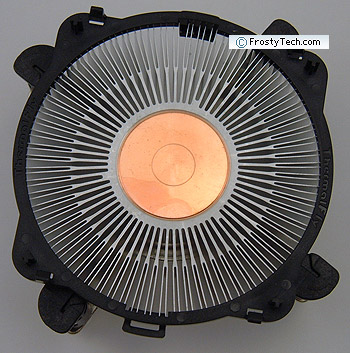 |
Heatsink
Top:
With the fan support structure removed, the
unique design of Thermalfly's I75DUH heatsink is apparent. The copper slug
is a whopping 33mm thick; most bifurcated fin heatsinks have cores made from hollowed
out copper rods - not solid ones which will tend to retain
heat directly behind the fan motor where there is no airflow.
The aluminum which surrounds the copper
core is 90mm in diameter, though each side is comprised of 2.5mm
of aluminum and ~26mm long straight bifurcated cooling fins. Each fin is
0.8mm thick and spaced 1.0mm apart at the base. The tips of the
bifurcated fin are a scant 0.2mm thick, and spaced 1.5mm apart. This
has to be among the thinnest extruded aluminum we've seen. |
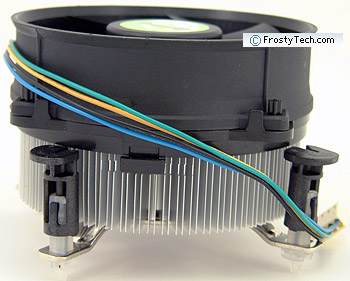 |
Heatsink
Side A:
The body of the Thermalfly I75DUH heatsink 28mm tall, and the heatsink has
an overall height of 63mm. The plastic clips lock directly into the 4mm
motherboard mounting holes which surround the LGA775 processor socket. To release
the heatsink from the board, the black portion of the clip is rotated 90
degrees and pulled upwards. The heatsink then pulls free of the board. |
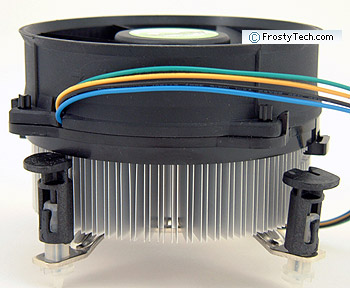 |
Heatsink Side B:
The fan support frame locks onto the aluminum portion
of the I75DUH heatsink with a couple slashes cut into the side of the
fins. The fan frame is held in tension, so vibration and rattling isn't a problem. Air
is exhausted outwards from the cooling fins, where it can then be used to cool adjacent board-mounted components. Most
socket 775 Intel motherboards are designed to use this source of airflow, and so VRM and chipset heatsinks are
often entirely passive. |
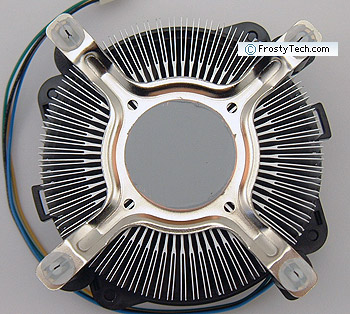 |
Heatsink Base:
The copper base of
the Thermalfly I75DUH heatsink is 35mm in diameter where it makes contact with
the processors' integrated heatspreader (IHS). The heatsink ships with a thin grey pad of
ShinEtsu thermal interface material thoughtfully pre-applied. The copper is machined perfectly flat, and is very smooth. Surface roughness is on the order of ~8
microinches, which is considered excellent. Owing to the pinless design of the LGA775
processor and socket, the mounting clips and hardware on the heatsink are rigid
mounts. It's the CPU in the socket which provides the flex, by means of
its many springy electrical contacts. |
|
 |
Websites you may also like:
PCSTATS
|
|
 |


